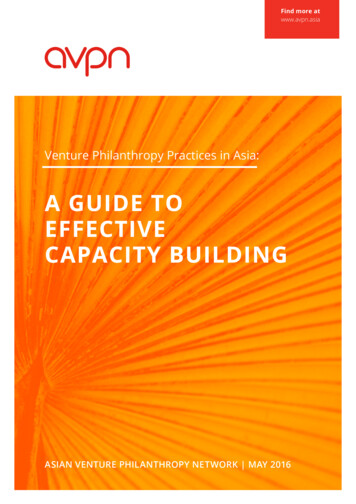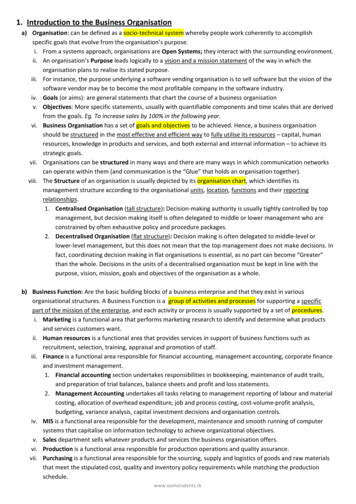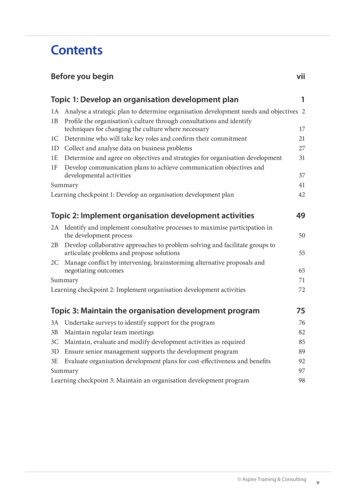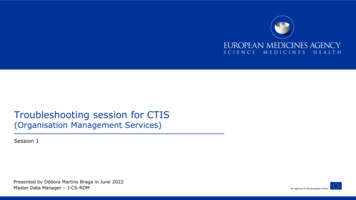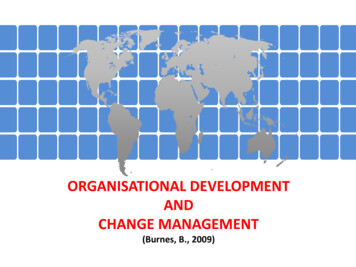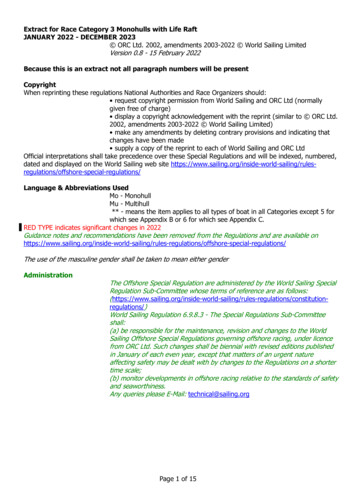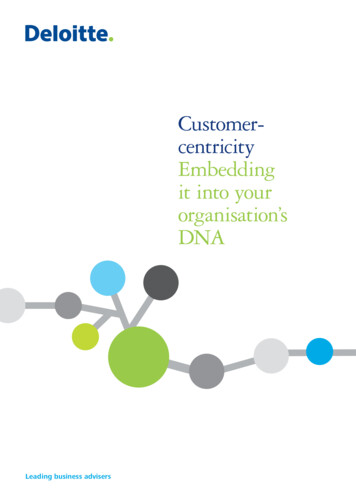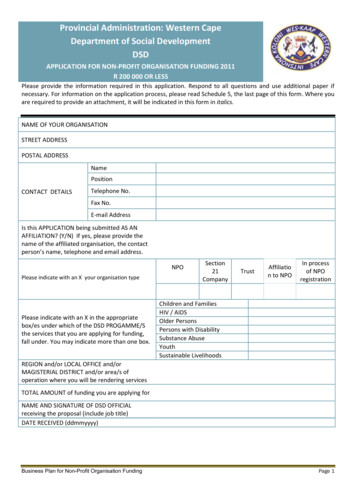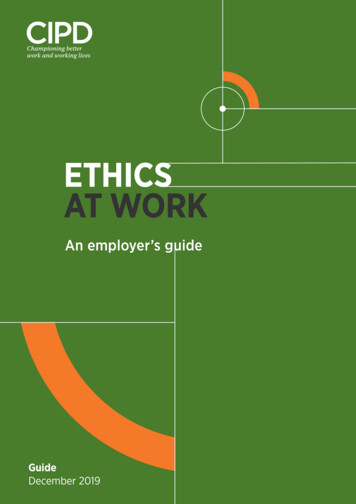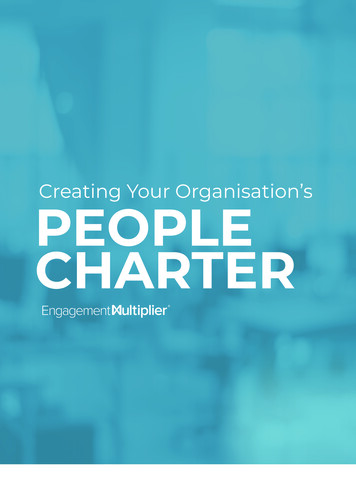
Transcription
Creating Your Organisation’sPEOPLECHARTER
Creating Your Organisation’s People CharterAs the dust starts to settle and we move into the post-Covid era, we are seeing a dramatic shiftin employee expectations and what they are prioritising in terms of employee experience.A sense of belonging is the number one thing they crave. As a result of the pandemic, they arefighting the effects of isolation, and are seeking safety and stability.For many leaders, this is a daunting change. Before the pandemic, the focus was on meetingemployees’ needs for professional development and providing career opportunities, both ofwhich are well understood.But a sense of belonging? That is something entirely new. How does one create a sense ofbelonging?Here’s the good news. This guide will provide you a structure and framework that will lay thefoundation for developing a sense of belonging for your organisation. Best of all, it will work forany team.And it’s easy.We start with the key to understanding employee behaviour: their feelings. Yes, I know this willfeel uncomfortable for some readers, but the fact is, feelings drive human behaviour, and alwayshave. Your employees are no different.By following the steps in this guide, you will: Create new energy and a strong sense of alignment within the leadership team, Demonstrate you care with the development of your organisation’s People Charter, andunderstand how well the company is executing its vision for its people, Develop a new set of guide rails for employees, workplace behaviour, and culture that willultimately make leaders’ jobs easier.Businesses that will triumph in 2021 and beyond are those that can show that they careabout their employees’ feelings and create an environment that provides a profound sense ofbelonging. The process of creating and publishing your company’s People Charter will lay theessential groundwork for building that sense of belonging for your people.It’s impossible to know all of the problems that exist in your business, but it is both possibleand practical to let your employees know that you care and to therefore garner the insight andinformation needed to deliver an exceptional employee experience. This guide provides youwith a structure and framework to do just that.STEFAN WISSENBACHFounder
STEP 1ALIGNAlign leadership on how you want your employees to feel.Creating your organisation’s People Charter starts with the leadership team answering thequestion “How do we want our employees to feel?” Open the floor to your senior team and brainstorm your answers to that question. Don’t over-analyse your thinking at this stage. This is an opportunity to engage in an openexchange of views. Capture all the answers in a list.Why the focus on employee feelings? Simple. We start with feelings first, because feelings driveemployees’ decisions and behaviour.STEP 2REFINEIn the same meeting, take thestatement list and select betweensix and 12 statements your teamfeels are most important.After the brainstorming session, the nextstep is for the leadership team to reviewHere’s an example of a list created by the EngagementMultiplier executive team completing this exercise:Safe returningA sense of beloTheir contributto the officenging to sometion is valuedhing specialThey understand the contribution their rolemakes to the overall success ofthe companyRespectedExcited aboutthe future of thebusinessthe responses, and select betweenThat they nevesix and 12 feelings the team feels areWe care aboutthmost important. Don’t be surprisedThey're in the right role that matches theirstrengthsif this exercise sparks a robust andenlightening discussion amongst yourleaders.TIPTheir opinion mThere's opportr want to leaveeir personal growthattersunity ahead for career growthWe genuinelycare about our team membewellbeingrsWe live by ourvaluesdozens of feelings statements duringConfidence inleadership to achieve thebusiness's goalstheir brainstorming session. In theseConfident in thSome teams end up generatingcases, it’s useful to groom the list,deleting duplicates, and organisingstatements by theme, to more easilyidentify the feelings leadership willprioritise.e direction of businessEach employeecan be open, honest andtransparent intheir communicationEnergised by our PurposeThey personallyfeel they are making adifference in peoples' livesPage 2 Creating Your Organisation’s People Charter
STEP 3CREATEUse your prioritised statements to draft your People Charter.Your People Charter communicates to your people the employee experience the company aimsto deliver, and frames that experience in how leaders hope employees will perceive and feelabout working for the organisation.TIPS Begin each statement with “You,” addressing employees on a personal level. How the leadership team wants employees to feel forms the heart of your People Charter,so don’t shy away from using the word “feel.” We recommend framing the Charter with a message from leadership, signaling yourcommitment to employees.Sample People CharterAt [XXX Company], we are committed to creating a work experience everyone values.How you feel while working here is central to your experience. This People Charterdetails how we believe our employees have the right to feel in our workplace: You feel safe. You feel respected by colleagues and leadership. You feel proud of your work. You feel valued. You feel supported by your manager and the organisation when it comes to yourpersonal and career growth. You feel excited and confident about the company’s future. You feel empowered to live our values every day. You feel a sense of belonging to something special. You feel energised by our purpose.Creating these conditions is a shared obligation amongst us all, and one we undertakeeach day. Together, we can create a positive, energising culture and experience inwhich we all can thrive.Signed, [CEO]Page 3 Creating Your Organisation’s People Charter
STEP 4 SHAREShare your People Charter with your whole team, ideally at a company-wide meeting and/orvia an announcement to all employees.Key points you may wish to make: Show the team your passion, and focus on them. This is an important opportunity tomake a powerful impression on your people, and open the channels for more (and moremeaningful) conversations in the future. Position your People Charter as a statement of “our commitment to you, our employees,”speaking to them directly. Emphasise the mutual obligation - such as their participation and feedback - that’sneeded to make fulfilling the People Charter for all employees a reality.STEP 5 ASKGather feedback from your team on how well the company meets the aims of its PeopleCharter.The next step is to turn the list of People Charterstatements into an employee survey. Surveyingyour team will tell you how well the company isdoing at providing the employee experience itI feel that Engagement Mul tiplieroffers opportunity for career growth.aims to deliver and will highlight any areas thatStrongly agreneed improvement to ensure your business isAgreefulfilling its People Charter.Neither agreeSimply start by prefacing your selectedDisagreePeople Charter statements with ‘I feel’ tocreate questions your team can respond to.enor disagreeStrongly disagreeFor maximum insight, be sure to keep yourstatements short and unambiguous.You may want to explore different elements relating to specific employee feelings via youremployee survey. For example, the idea of respect in the workplace is a broad one, comprisingrespect from one’s manager, respect from one’s colleagues, and whether one feels respectedas an individual. In this case, you may want to ask employees to respond to three separatestatements related to respect in your survey: I feel respected as an individual I feel respected by my manager I feel respected by my colleaguesPage 4 Creating Your Organisation’s People Charter
Important Note: For an additional layer of insight, we recommend adding the following twoopen-ended questions at the end of your survey: How did taking this survey make you feel? Is there any additional information you would like to share?Best practices for a successful survey: Employee engagement survey best practices canbe boiled down into three areas: timing, participation, and follow-up.Find more details and sample messages you can use in thearticle, “Employee Engagement Survey Best Practices.”STEP 6Read MoreRESPONDRespond to the team’s feedback.Once your survey closes and you have the results in hand, gather the leadership team to reviewand analyse survey results and employee feedback.Select three actions to take over the next 90 days that will close the gaps between theexperience described in the company’s People Charter, and the feedback you have receivedfrom your employees.Communicate these plans - along with timelines and planned outcomes - to your team, and besure to update them on the progress over the following months.Remember, this is an opportunity to prove leadership’s seriousness about living up to thepromises of the People Charter, involve your people, and indicate to them that this isn’t simply a“tick the box” exercise.Page 5 Creating Your Organisation’s People Charter
Help with creating your on-demand survey:Current Engagement Multiplier clients - if you needI’m excited aboutthe future of thebusiness.assistance creating an on-demand survey, please contact yourClient Success Manager.If you’re new to Engagement Multiplier, we will provide youwith free resources to complete this survey.Register for your free survey and a member of our team willcontact you to provide support and guidance.signup.engagementmultiplier.com/engageIn closing:As your organisation continues to survey employees and act upon their feedback, you’ll noticeseveral things. The feedback will become more thoughtful and sophisticated, as employeesrealise that they are being heard. Participation rates may improve, as even the skeptics are wonover. And speaking of the skeptics, as they see results and their enthusiasm increases, you’llenjoy a measurably higher rate of engagement.You’ll also see how the simple act of focusing on how people feel will lift engagement.The People Charter brings a new layer into the engagement picture. It’s a great way to showboth existing employees and future hires that you care, and lays the foundation for creatingthat crucial sense of belonging that is so important today. That which gets measured gets done,and by asking your team how well the organisation is fulfilling the commitments outlined in theCharter, you’re doing two things: signaling strongly that the organisation cares, and continuallyexpanding the sense of belonging amongst your employees.CONNECT WITH US!42 Berkeley Square, Mayfair, London, W1J 5AW 44 (0) 2071 83056242 Berkeley Square, Mayfair, London, W1J 5AW 44183 0562130(0)E. 207RandolphStreet, Suite 1600, Chicago IL 60601-6220773-340-0381130 E. Randolph Street, Suite 1600, Chicago IL 60601-6220www.engagementmultiplier.com773-340-0381 2021 Global Magic Futures Ltd. All rights reserved. Used with written permission. Patent pending.www.engagementmultiplier.com 2018 Global Magic Futures Ltd. All rights reserved. Used with written permission. Patent pending.Version 1.0Page 6 Creating Your Organisation’s People Charter@EMultiplier WITH US!D CONNECT@EMultiplierC Engagement-MultiplierEngagement-MultiplierE youtubeM bit.ly/EM-youtube
fulfilling its People Charter. Simply start by prefacing your selected People Charter statements with 'I feel' to create questions your team can respond to. For maximum insight, be sure to keep your statements short and unambiguous. You may want to explore different elements relating to specific employee feelings via your employee survey.
